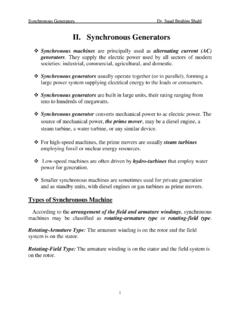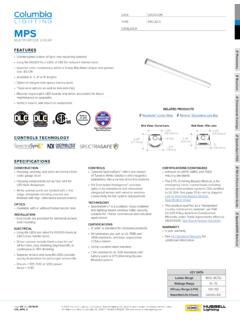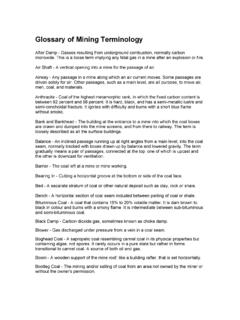Transcription of 1. Classification of materials
1 1 Chapter 1: Classification of of materials :Solid materials have been conveniently grouped into three basicclassifications: metals, ceramics, and polymers. This scheme is basedprimarily on chemical makeup andatomicstructure, and most materialsfall into one distinct grouping or another,although there are someintermediates. In addition, there are the composites, combinationsof twoor more of the above three basic material classes. A brief explanationofthese material types and representative characteristics is offered advanced materials those used in high-technology applications viz.
2 Semiconductors, biomaterials, smartmaterials, and nanoengineered MetalsMaterialsin this group are composed of one or more metallic elements(such as iron, aluminum, copper, titanium, gold, and nickel), and oftenalso nonmetallic elements (forexample, carbon, nitrogen, and oxygen) inrelatively small amounts. Atoms in metalsand theiralloys are arranged ina very orderly manner and in comparison to the ceramics and polymers,are relatively dense (Figure ).WithFigure of room temperaturedensityvalues for variousmetals,ceramics,polymers, andcompositematerials2 Chapter 1: Classification of to mechanical characteristics, these materials are relatively stiff(Figure ) and strong (Figure ), yet are ductile ( , capable of largeamounts of deformationwithout fracture), and are resistant to fracture(Figure ), whichaccounts for theirwidespread use in structuralapplications.
3 metallic materials have large numbers ofnonlocalizedelectrons; that is, these electrons are not bound to particular atoms. Manyproperties of metals are directly attributable to these electrons. Forexample, metalsare extremely good conductors of electricity (Figure )and heat, and are not transparentto visible light; a polished metal surfacehas a lustrous appearance. In addition,some of the metals (viz., Fe, Co,and Ni) have desirablemagnetic a photograph that shows several common and familiarobjects thatare made of metallic CeramicsCeramics are compounds between metallic and nonmetallic elements;they are mostfrequently oxides, nitrides,and carbides.
4 For example,some of the common ceramicFigure ofroom temperatureStiffness( , elastic modulus) values forvariousmetals, ceramics,polymers, andcomposite 1: Classification of of room temperaturestrength( , tensile strength)valuesforvariousmetals, ceramics,polymers, andcomposite materialsmaterials include aluminum oxide (or alumina,Al2O3), silicon dioxide (orsilica, SiO2), silicon carbide (SiC), silicon nitride (Si3N4), and, inaddition, what some refer to asthe traditional ceramics those composedof clay minerals ( , porcelain), as well ascement, and glass. Withregard to mechanical behavior, ceramic materials are relativelystiff andstrong stiffnesses and strengths are comparable to those of the metals(Figures ).
5 In addition, ceramics are typically very hard. Onthe otherhand, they are extremely brittle (lack ductility), and are highlysusceptible to fracture(Figure ). These materials are typicallyinsulative to the passage of heat and electricity( , have low electricalconductivities, Figure ), and are more resistant tohigh temperaturesand harsh environments than metals and polymers. With regard toopticalcharacteristics, ceramics may be transparent, translucent,oropaque(as shown in figure (A)), and some of the oxide ceramics ( , Fe3O4)exhibit magnetic 1: Classification of (A)Photograph of three thin disk specimens of aluminum oxide, which havebeenplaced over a printed pagein order to demonstrate their differencesin of room-temperature resistance to fracture ( , fracturetoughness)for various metals, ceramics, polymers, and 1.
6 Classification of of roomtemperatureelectricalconductivity rangesfor metals,ceramics, polymers, PolymersPolymers include the familiar plastic and rubber materials . Many of themare organiccompounds that are chemicallybased on carbon, hydrogen,and other nonmetallicelements ( ,N, and Si). Furthermore, they havevery large molecular structures, often chain-like in nature that have abackbone of carbon atoms. Some of the commonand familiar polymersare polyethylene(PE), nylon, poly(vinyl chloride)(PVC), polycarbonate(PC), polystyrene (PS), and silicone rubber. These materialstypicallyhave low densities (Figure ), whereas their mechanical characteristicsare generally dissimilar to the metallic and ceramicmaterials they arenot as stiffnor as strong as these other material types (Figures ).
7 However, on thebasis of their low densities, many times theirstiffnesses and strengths on a per 1: Classification of that aremade of metals andmetal alloys: (fromleft toright)silverware (fork andknife), scissors, coins,a gear, a weddingring,and a nut objectsthat are made ofceramic materials :scissors, a china teacup, a building brick,afloor tile, and aglass are comparable to the metals and ceramics. In addition, many of thepolymersare extremely ductile and pliable ( , plastic), which meansthey are easily formedinto complex shapes. In general, they are relativelyinert chemically and unreactivein a large number of environments.
8 Onemajor drawback to the polymers is theirtendency to soften and/ordecompose at modest temperatures, which, in some instances, limits their7 Chapter 1: Classification of Furthermore, they have low electrical conductivities ( ) andare photograph in Figure several articles made of polymersthat arefamiliar to the objectsthat are made ofpolymericmaterials: plastictableware(spoon, fork, andknife), billiard balls,a bicycle helmet, twodice, a lawnmowerwheel (plastic huband rubber tire), anda plastic CompositesA composite is composed of two (or more) individual materials , whichcome fromthe categories discussed above viz.
9 , metals, ceramics, andpolymers. The design goalof a composite is to achieve a combination ofproperties that is not displayed byany single material , and also toincorporate the best characteristics of each of thecomponentmaterials. Alarge number of composite types exist that are representedby differentcombinations of metals, ceramics, and polymers. Furthermore, somenaturally-occurring materials are also considered to be composites forexample,wood and bone. However,most of those we consider in ourdiscussions are synthetic(or man-made) of the most common and familiar composites is fiberglass, in whichsmallglass fibers are embedded within a polymeric material (normally anepoxy orpolyester).
10 The glass fibers are relatively strong and stiff (butalso brittle), whereasthe polymer is ductile (but also weak and flexible).8 Chapter 1: Classification of , the resulting fiberglass isrelatively stiff, strong, (Figures ) flexible, and ductile. In addition, it hasa low density (Figure ).Another of these technologically important materials is the carbon fiberreinforcedpolymer (or CFRP ) composite carbon fibers that areembedded withina polymer. These materials are stiffer and stronger thanthe glass fiber-reinforcedmaterials (Figures ), yet they aremore expensive. The CFRP composites are used in some aircraft andaerospace applications, as well as high-tech sportingequipment ( ,bicycles, golf clubs, tennis rackets, and skis/snowboards).














